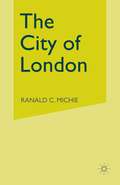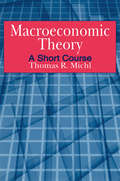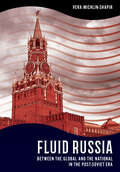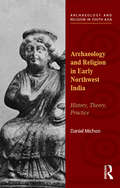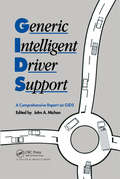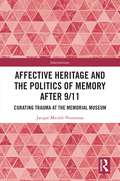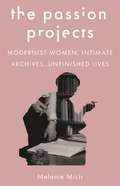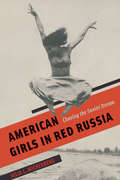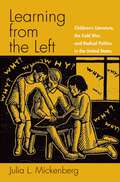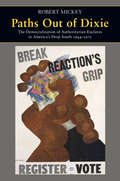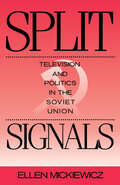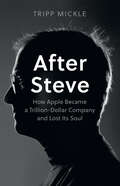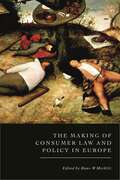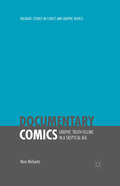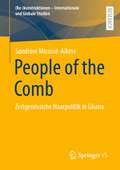- Table View
- List View
The City of London: Continuity and Change, 1850–1990
by Ronald C. MichieWhat is the City of London? The term is in everyday use but few are willing to define it. If pressed some will suggest that it means the entire UK financial sector while others point to a particular part of London - the Square Mile. Neither of these definitions is adequate because the City is both greater and less than either finance alone or a physical location. The author demonstrates that it is only by taking a detailed look at the City over the last 100 years that it can be understood.
Macroeconomic Theory: A Short Course
by Thomas R. MichlA look at all the key topics in intermediate-level macroeconomic theory with carefully chosen linear versions of the standard models of both the closed and the open economy. It requires no mathematical proficiency beyond high school level algebra, and has been thoroughly tested in the classroom.
Macroeconomic Theory: A Short Course
by Thomas R. MichlA look at all the key topics in intermediate-level macroeconomic theory with carefully chosen linear versions of the standard models of both the closed and the open economy. It requires no mathematical proficiency beyond high school level algebra, and has been thoroughly tested in the classroom.
Fluid Russia: Between the Global and the National in the Post-Soviet Era (NIU Series in Slavic, East European, and Eurasian Studies)
by Vera Michlin-ShapirFluid Russia offers a new framework for understanding Russian national identity by focusing on the impact of globalization on its formation, something which has been largely overlooked. This approach sheds new light on the Russian case, revealing a dynamic Russian identity that is developing along the lines of other countries exposed to globalization. Vera Michlin-Shapir shows how along with the freedoms afforded when Russia joined the globalizing world in the 1990s came globalization's disruptions.Michlin-Shapir describes Putin's rise to power and his project to reaffirm a stronger identity not as a uniquely Russian diversion from liberal democracy, but as part of a broader phenomenon of challenges to globalization. She underlines the limits of Putin's regime to shape Russian politics and society, which is still very much impacted by global trends. As well, Michlin-Shapir questions a prevalent approach in Russia studies that views Russia's experience with national identity as abnormal or defective, either being too week or too aggressive.What is offered is a novel explanation for the so-called Russian identity crisis. As the liberal postwar order faces growing challenges, Russia's experience can be an instructive example of how these processes unfold. This study ties Russia's authoritarian politics and nationalist rallying to the shortcomings of globalization and neoliberal economics, potentially making Russia "patient zero" of the anti-globalist populist wave and rise of neo-authoritarian regimes. In this way, Fluid Russia contributes to the broader understanding of national identity in the current age and the complexities of identity formation in the global world.
Archaeology and Religion in Early Northwest India: History, Theory, Practice (Archaeology and Religion in South Asia)
by Daniel MichonThis book explores the ways in which past cultures have been used to shape colonial and postcolonial cultural identities. It provides a theoretical framework to understand these processes, and offers illustrative case studies in which the agency of ancient peoples, rather than the desires of antiquarians and archaeologists, is brought to the fore.
Archaeology and Religion in Early Northwest India: History, Theory, Practice (Archaeology and Religion in South Asia)
by Daniel MichonThis book explores the ways in which past cultures have been used to shape colonial and postcolonial cultural identities. It provides a theoretical framework to understand these processes, and offers illustrative case studies in which the agency of ancient peoples, rather than the desires of antiquarians and archaeologists, is brought to the fore.
Generic Intelligent Driver Support
by J. A. MichonThis book summarizes the activities of the Generic Intelligent Driver Support (GIDS) Consortium and offers recommendations for successful GIDS implementation. It is based on the GIDS Project, a part of the EC-funded Dedicated Road Infrastructure for Vehicle Safety in Europe Programme.
Generic Intelligent Driver Support
by John A. MichonThis book summarizes the activities of the Generic Intelligent Driver Support (GIDS) Consortium and offers recommendations for successful GIDS implementation. It is based on the GIDS Project, a part of the EC-funded Dedicated Road Infrastructure for Vehicle Safety in Europe Programme.
Affective Heritage and the Politics of Memory after 9/11: Curating Trauma at the Memorial Museum (Interventions)
by Jacque Micieli-VoutsinasThis book critically examines the institutional curation of traumatic memory at the 9/11 Memorial Museum and its evocative power as a cultural storyteller. Memorial Museums are evocative spaces. Drawing on aesthetic practices deeply rooted in representing the ‘unrepresentability’ of cultural trauma, most notably the Holocaust, Memorial Museums are powerful, popular mediums for establishing cultural values, asking the visitor to contemplate "Who am I?" in relation to the difficult histories on display. Using primary data, this book poses important questions about the emotionally-charged site: what ‘moral lessons’ are visitors imparted with at the 9/11 Memorial Museum? Who is the cultural institution’s primary audience—the imagined community it reconstructs this traumatic history and safeguards its memories for? What does the National September 11 Memorial & Museum ultimately teach visitors about history, ourselves, and others? This work will be of interest to students and scholars in the areas of Human Geography, American Studies, Museum Studies and Public History, Cultural and Heritage Studies, and Trauma and Memory Studies.
Affective Heritage and the Politics of Memory after 9/11: Curating Trauma at the Memorial Museum (Interventions)
by Jacque Micieli-VoutsinasThis book critically examines the institutional curation of traumatic memory at the 9/11 Memorial Museum and its evocative power as a cultural storyteller. Memorial Museums are evocative spaces. Drawing on aesthetic practices deeply rooted in representing the ‘unrepresentability’ of cultural trauma, most notably the Holocaust, Memorial Museums are powerful, popular mediums for establishing cultural values, asking the visitor to contemplate "Who am I?" in relation to the difficult histories on display. Using primary data, this book poses important questions about the emotionally-charged site: what ‘moral lessons’ are visitors imparted with at the 9/11 Memorial Museum? Who is the cultural institution’s primary audience—the imagined community it reconstructs this traumatic history and safeguards its memories for? What does the National September 11 Memorial & Museum ultimately teach visitors about history, ourselves, and others? This work will be of interest to students and scholars in the areas of Human Geography, American Studies, Museum Studies and Public History, Cultural and Heritage Studies, and Trauma and Memory Studies.
The Passion Projects: Modernist Women, Intimate Archives, Unfinished Lives
by Professor Melanie MicirHow modernist women writers used biographical writing to resist their exclusion from literary historyIt’s impossible, now, to think of modernism without thinking about gender, sexuality, and the diverse movers and shakers of the early twentieth century. But this was not always so. The Passion Projects examines biographical projects that modernist women writers undertook to resist the exclusion of their friends, colleagues, lovers, and companions from literary history. Many of these works were vibrant efforts of modernist countermemory and counterhistory that became casualties in a midcentury battle for literary legitimacy, but that now add a new dimension to our appreciation of such figures as Radclyffe Hall, Gertrude Stein, Hope Mirrlees, and Sylvia Beach, among many others.Melanie Micir explores an extensive body of material, including Sylvia Townsend Warner’s carefullly annotated letters to her partner Valentine Ackland, Djuna Barnes’s fragmented drafts about the Baroness Elsa von Freytag-Loringhoven, Margaret Anderson’s collection of modernist artifacts, and Virginia Woolf’s joke biography of her friend and lover Vita Sackville-West, the novel Orlando. Whether published in encoded desire or squirreled away in intimate archives, these “passion projects” recorded life then in order to summon an audience now, and stand as important predecessors of queer and feminist recovery projects that have shaped the contemporary understanding of the field.Arguing for the importance of biography, The Passion Projects shows how women turned to this genre in the early twentieth century to preserve their lives and communities for future generations to discover.
The Passion Projects: Modernist Women, Intimate Archives, Unfinished Lives
by Professor Melanie MicirHow modernist women writers used biographical writing to resist their exclusion from literary historyIt’s impossible, now, to think of modernism without thinking about gender, sexuality, and the diverse movers and shakers of the early twentieth century. But this was not always so. The Passion Projects examines biographical projects that modernist women writers undertook to resist the exclusion of their friends, colleagues, lovers, and companions from literary history. Many of these works were vibrant efforts of modernist countermemory and counterhistory that became casualties in a midcentury battle for literary legitimacy, but that now add a new dimension to our appreciation of such figures as Radclyffe Hall, Gertrude Stein, Hope Mirrlees, and Sylvia Beach, among many others.Melanie Micir explores an extensive body of material, including Sylvia Townsend Warner’s carefullly annotated letters to her partner Valentine Ackland, Djuna Barnes’s fragmented drafts about the Baroness Elsa von Freytag-Loringhoven, Margaret Anderson’s collection of modernist artifacts, and Virginia Woolf’s joke biography of her friend and lover Vita Sackville-West, the novel Orlando. Whether published in encoded desire or squirreled away in intimate archives, these “passion projects” recorded life then in order to summon an audience now, and stand as important predecessors of queer and feminist recovery projects that have shaped the contemporary understanding of the field.Arguing for the importance of biography, The Passion Projects shows how women turned to this genre in the early twentieth century to preserve their lives and communities for future generations to discover.
American Girls in Red Russia: Chasing the Soviet Dream
by Julia L. MickenbergIf you were an independent, adventurous, liberated American woman in the 1920s or 1930s where might you have sought escape from the constraints and compromises of bourgeois living? Paris and the Left Bank quickly come to mind. But would you have ever thought of Russia and the wilds of Siberia? This choice was not as unusual as it seems now. As Julia L. Mickenberg uncovers in American Girls in Red Russia, there is a forgotten counterpoint to the story of the Lost Generation: beginning in the late nineteenth century, Russian revolutionary ideology attracted many women, including suffragists, reformers, educators, journalists, and artists, as well as curious travelers. Some were famous, like Isadora Duncan or Lillian Hellman; some were committed radicals, though more were just intrigued by the “Soviet experiment.” But all came to Russia in search of social arrangements that would be more equitable, just, and satisfying. And most in the end were disillusioned, some by the mundane realities, others by horrifying truths. Mickenberg reveals the complex motives that drew American women to Russia as they sought models for a revolutionary new era in which women would be not merely independent of men, but also equal builders of a new society. Soviet women, after all, earned the right to vote in 1917, and they also had abortion rights, property rights, the right to divorce, maternity benefits, and state-supported childcare. Even women from Soviet national minorities—many recently unveiled—became public figures, as African American and Jewish women noted. Yet as Mickenberg’s collective biography shows, Russia turned out to be as much a grim commune as a utopia of freedom, replete with economic, social, and sexual inequities. American Girls in Red Russia recounts the experiences of women who saved starving children from the Russian famine, worked on rural communes in Siberia, wrote for Moscow or New York newspapers, or performed on Soviet stages. Mickenberg finally tells these forgotten stories, full of hope and grave disappointments.
Learning from the Left: Children's Literature, the Cold War, and Radical Politics in the United States
by Julia L. MickenbergAt the height of the Cold War, dozens of radical and progressive writers, illustrators, editors, librarians, booksellers, and teachers cooperated to create and disseminate children's books that challenged the status quo. Learning from the Left provides the first historic overview of their work. Spanning from the 1920s, when both children's book publishing and American Communism were becoming significant on the American scene, to the late 1960s, when youth who had been raised on many of the books in this study unequivocally rejected the values of the Cold War, Learning from the Left shows how "radical" values and ideas that have now become mainstream (including cooperation, interracial friendship, critical thinking, the dignity of labor, feminism, and the history of marginalized people), were communicated to children in repressive times. A range of popular and critically acclaimed children's books, many by former teachers and others who had been blacklisted because of their political beliefs, made commonplace the ideas that McCarthyism tended to call "subversive." These books, about history, science, and contemporary social conditions-as well as imaginative works, science fiction, and popular girls' mystery series-were readily available to children: most could be found in public and school libraries, and some could even be purchased in classrooms through book clubs that catered to educational audiences. Drawing upon extensive interviews, archival research, and hundreds of children's books published from the 1920s through the 1970s, Learning from the Left offers a history of the children's book in light of the history of the history of the Left, and a new perspective on the links between the Old Left of the 1930s and the New Left of the 1960s. Winner of the Grace Abbott Book Prize of the Society for the History of Children and Youth
Learning from the Left: Children's Literature, the Cold War, and Radical Politics in the United States
by Julia L. MickenbergAt the height of the Cold War, dozens of radical and progressive writers, illustrators, editors, librarians, booksellers, and teachers cooperated to create and disseminate children's books that challenged the status quo. Learning from the Left provides the first historic overview of their work. Spanning from the 1920s, when both children's book publishing and American Communism were becoming significant on the American scene, to the late 1960s, when youth who had been raised on many of the books in this study unequivocally rejected the values of the Cold War, Learning from the Left shows how "radical" values and ideas that have now become mainstream (including cooperation, interracial friendship, critical thinking, the dignity of labor, feminism, and the history of marginalized people), were communicated to children in repressive times. A range of popular and critically acclaimed children's books, many by former teachers and others who had been blacklisted because of their political beliefs, made commonplace the ideas that McCarthyism tended to call "subversive." These books, about history, science, and contemporary social conditions-as well as imaginative works, science fiction, and popular girls' mystery series-were readily available to children: most could be found in public and school libraries, and some could even be purchased in classrooms through book clubs that catered to educational audiences. Drawing upon extensive interviews, archival research, and hundreds of children's books published from the 1920s through the 1970s, Learning from the Left offers a history of the children's book in light of the history of the history of the Left, and a new perspective on the links between the Old Left of the 1930s and the New Left of the 1960s. Winner of the Grace Abbott Book Prize of the Society for the History of Children and Youth
Paths Out of Dixie: The Democratization of Authoritarian Enclaves in America's Deep South, 1944-1972
by Robert MickeyThe transformation of the American South--from authoritarian to democratic rule--is the most important political development since World War II. It has re-sorted voters into parties, remapped presidential elections, and helped polarize Congress. Most important, it is the final step in America's democratization. Paths Out of Dixie illuminates this sea change by analyzing the democratization experiences of Georgia, Mississippi, and South Carolina. Robert Mickey argues that Southern states, from the 1890s until the early 1970s, constituted pockets of authoritarian rule trapped within and sustained by a federal democracy. These enclaves--devoted to cheap agricultural labor and white supremacy--were established by conservative Democrats to protect their careers and clients. From the abolition of the whites-only Democratic primary in 1944 until the national party reforms of the early 1970s, enclaves were battered and destroyed by a series of democratization pressures from inside and outside their borders. Drawing on archival research, Mickey traces how Deep South rulers--dissimilar in their internal conflict and political institutions--varied in their responses to these challenges. Ultimately, enclaves differed in their degree of violence, incorporation of African Americans, and reconciliation of Democrats with the national party. These diverse paths generated political and economic legacies that continue to reverberate today. Focusing on enclave rulers, their governance challenges, and the monumental achievements of their adversaries, Paths Out of Dixie shows how the struggles of the recent past have reshaped the South and, in so doing, America's political development.
Paths Out of Dixie: The Democratization of Authoritarian Enclaves in America's Deep South, 1944-1972
by Robert MickeyThe transformation of the American South--from authoritarian to democratic rule--is the most important political development since World War II. It has re-sorted voters into parties, remapped presidential elections, and helped polarize Congress. Most important, it is the final step in America's democratization. Paths Out of Dixie illuminates this sea change by analyzing the democratization experiences of Georgia, Mississippi, and South Carolina. Robert Mickey argues that Southern states, from the 1890s until the early 1970s, constituted pockets of authoritarian rule trapped within and sustained by a federal democracy. These enclaves--devoted to cheap agricultural labor and white supremacy--were established by conservative Democrats to protect their careers and clients. From the abolition of the whites-only Democratic primary in 1944 until the national party reforms of the early 1970s, enclaves were battered and destroyed by a series of democratization pressures from inside and outside their borders. Drawing on archival research, Mickey traces how Deep South rulers--dissimilar in their internal conflict and political institutions--varied in their responses to these challenges. Ultimately, enclaves differed in their degree of violence, incorporation of African Americans, and reconciliation of Democrats with the national party. These diverse paths generated political and economic legacies that continue to reverberate today. Focusing on enclave rulers, their governance challenges, and the monumental achievements of their adversaries, Paths Out of Dixie shows how the struggles of the recent past have reshaped the South and, in so doing, America's political development.
Split Signals: Television and Politics in the Soviet Union (Communication and Society)
by Ellen MickiewiczTelevision has changed drastically in the Soviet Union over the last three decades. In 1960, only five percent of the population had access to TV, but now the viewing population has reached near total saturation. Today's main source of information in the USSR, television has become Mikhail Gorbachev's most powerful instrument for paving the way for major reform. Containing a wealth of interviews with major Soviet and American media figures and fascinating descriptions of Soviet TV shows, Ellen Mickiewicz's wide-ranging, vividly written volume compares over one hundred hours of Soviet and American television, covering programs broadcast during both the Chernenko and Gorbachev governments. Mickiewicz describes the enormous significance and popularity of news programs and discusses how Soviet journalists work in the United States. Offering a fascinating depiction of the world seen on Soviet TV, she also explores the changes in programming that have occurred as a result of glasnost.
After Steve: How Apple Became A Trillion-dollar Company And Lost Its Soul
by Tripp MickleFrom the Wall Street Journal’s Tripp Mickle, the dramatic, untold story inside Apple after the passing of Steve Jobs by following his top lieutenants—Jony Ive, the Chief Design Officer, and Tim Cook, the COO-turned-CEO—and how the fading of the former and the rise of the latter led to Apple losing its soul.
The Making of Consumer Law and Policy in Europe
by Hans W MicklitzThis book analyses the founding years of consumer law and consumer policy in Europe. It combines two dimensions: the making of national consumer law and the making of European consumer law, and how both are intertwined. The chapters on Germany, Italy, the Nordic countries and the United Kingdom serve to explain the economic and the political background which led to different legal and policy approaches in the then old Member States from the 1960s onwards. The chapter on Poland adds a different layer, the one of a former socialist country with its own consumer law and how joining the EU affected consumer law at the national level. The making of European consumer law started in the 1970s rather cautiously, but gradually the European Commission took an ever stronger position in promoting not only European consumer law but also in supporting the building of the European Consumer Organisation (BEUC), the umbrella organisation of the national consumer bodies. The book unites the early protagonists who were involved in the making of consumer law in Europe: Guido Alpa, Ludwig Krämer, Ewa Letowska, Hans-W Micklitz, Klaus Tonner, Iain Ramsay, and Thomas Wilhelmsson, supported by the younger generation Aneta Wiewiórowska Domagalska, Mateusz Grochowski, and Koen Docter, who reconstructs the history of BEUC. Niklas Olsen and Thomas Roethe analyse the construction of this policy field from a historical and sociological perspective.This book offers a unique opportunity to understand a legal and political field, that of consumer law and policy, which plays a fundamental role in our contemporary societies.
The Making of Consumer Law and Policy in Europe
by Hans-W MicklitzThis book analyses the founding years of consumer law and consumer policy in Europe. It combines two dimensions: the making of national consumer law and the making of European consumer law, and how both are intertwined. The chapters on Germany, Italy, the Nordic countries and the United Kingdom serve to explain the economic and the political background which led to different legal and policy approaches in the then old Member States from the 1960s onwards. The chapter on Poland adds a different layer, the one of a former socialist country with its own consumer law and how joining the EU affected consumer law at the national level. The making of European consumer law started in the 1970s rather cautiously, but gradually the European Commission took an ever stronger position in promoting not only European consumer law but also in supporting the building of the European Consumer Organisation (BEUC), the umbrella organisation of the national consumer bodies. The book unites the early protagonists who were involved in the making of consumer law in Europe: Guido Alpa, Ludwig Krämer, Ewa Letowska, Hans-W Micklitz, Klaus Tonner, Iain Ramsay, and Thomas Wilhelmsson, supported by the younger generation Aneta Wiewiórowska Domagalska, Mateusz Grochowski, and Koen Docter, who reconstructs the history of BEUC. Niklas Olsen and Thomas Roethe analyse the construction of this policy field from a historical and sociological perspective.This book offers a unique opportunity to understand a legal and political field, that of consumer law and policy, which plays a fundamental role in our contemporary societies.
Documentary Comics: Graphic Truth-Telling in a Skeptical Age (Palgrave Studies in Comics and Graphic Novels)
by Nina MickwitzCan comics be documentary, and can documentary take the form of, and thus be, comics? Examining comics as documentary, this book challenges the persistent assumption that ties documentary to recording technologies, and instead engages an understanding of the category in terms of narrative, performativity and witnessing. Through a cluster of early twenty-first century comics, Nina Mickwitz argues that these comics share a documentary ambition to visually narrate and represent aspects and events of the real world.
People of the Comb: Zeitgenössiche Haarpolitik in Ghana ((Re-)konstruktionen - Internationale und Globale Studien)
by Sandrine Micossé-Aikins"Afrika" dient in vielen haarpolitischen Debatten nur als positive und teilweise sehr unpräzise definierte Projektionsfläche, die für eine bessere vorkoloniale Schwarze Welt steht. Nur wenig Aufmerksamkeit wurde bisher darauf verwendet, die tatsächlich gegenwärtig gelebte Haarkultur- und -politik in verschiedenen kontinentalafrikanischen Kontexten auch auf ihr Eingebettet-Sein in globale, historisch gewachsene Hierarchien hin zu betrachten. Oft wird übersehen, dass auch hier – auf ihre eigene Weise – rassistische Ideologien und insbesondere weiße Vorherrschaft als koloniale Kontinuitäten wirken, und zeitgenössische Haarkultur mitprägen. Die vorliegende Arbeit möchte einen Beitrag dazu leisten, diese Dynamiken besser zu verstehen. Dabei werden jedoch auch relevante Facetten Schwarzen Selbstverständnisses und gelebte ästhetische Praktiken beleuchtet, die über die Auseinandersetzung mit weißer Vorherrschaft hinausweisen.
Performance Studies: The Basics (The Basics)
by Andreea S. MicuPerformance Studies: The Basics offers an overview of the multiple, often overlapping definitions of performance, from performance art, performance as everyday life, and rituals, to the performative dimensions of identity, such as gender, race and sexuality. This book defines the interdisciplinary field of performance studies as it has evolved over the past four decades at the intersection of academic scholarship and artistic and activist practices. It discusses performance as an important means of communicating and of understanding the world, highlighting its intersections with critical theory and arguing for the importance of performance in the study of human behaviour and social practices. Complete with a helpful glossary and bibliography, as well as suggestions for further reading, this book is an ideal starting point for those studying performance studies as well as for general readers with an interest in the subject.
